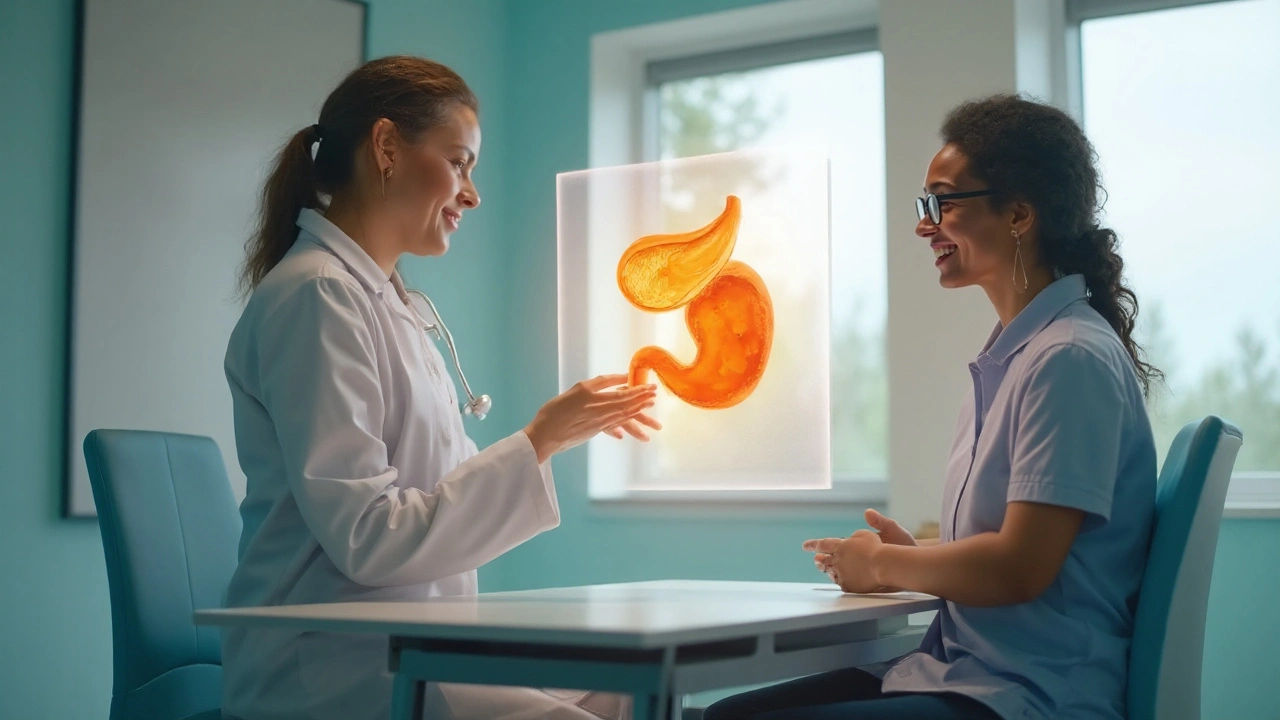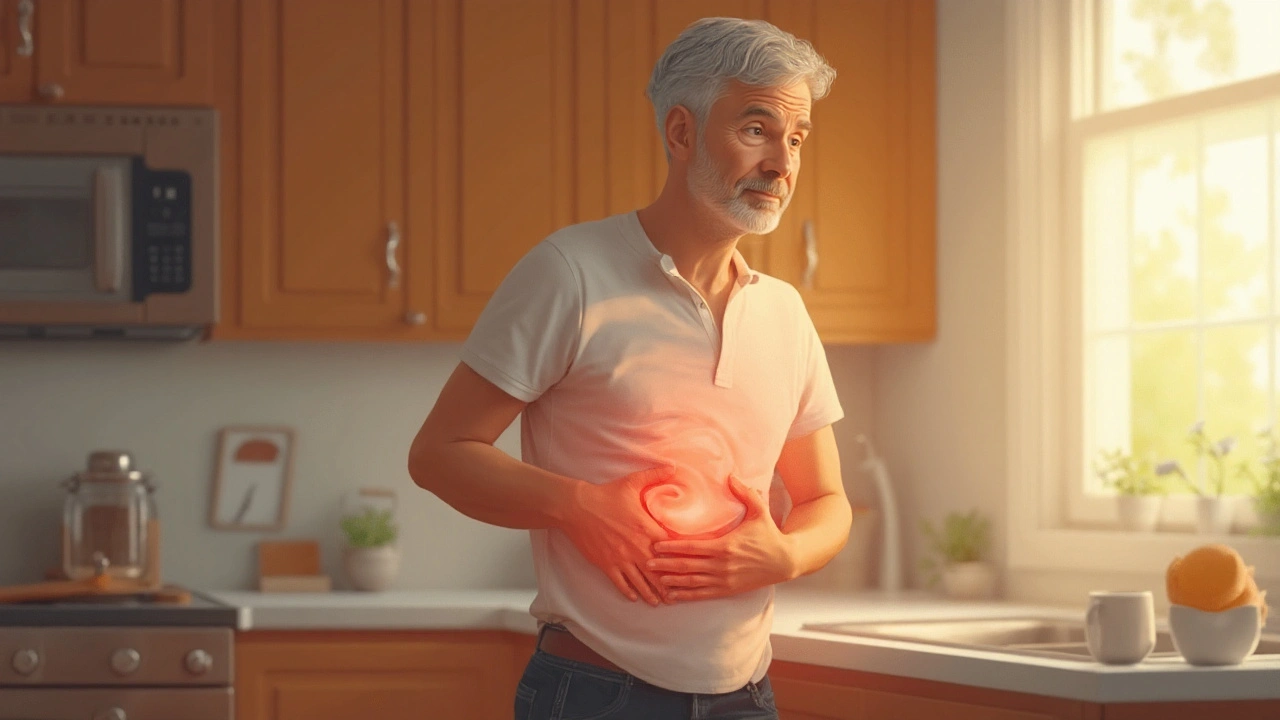Chronic pancreatitis is a long‑lasting inflammatory disease of the pancreas that gradually destroys the organ’s ability to produce digestive enzymes and insulin. It isn’t a one‑time event; the damage builds up over years, often hidden until pain or malnutrition forces a medical visit. Understanding the root causes, spotting the early clues, and choosing the right therapy can mean the difference between a manageable condition and serious complications like diabetes or pancreatic cancer.
What Triggers Persistent Inflammation?
Three major players dominate the landscape of chronic pancreatic injury. Below is a quick look at each, followed by a side‑by‑side table that highlights how they differ in patient profile, lab patterns, and imaging hallmarks.
| Cause | Typical Age of Onset | Key Lab Finding | Imaging Signature |
|---|---|---|---|
| Alcohol‑induced | 40‑60 years | Elevated serum trypsinogen | Calcifications scattered throughout the gland |
| Gallstone‑related | 30‑50 years | Pure bilirubin rise with intermittent spikes | Obstructive dilatation of the pancreatic duct |
| Autoimmune pancreatitis | 50‑70 years | IgG4‑positive plasma cells | Diffuse, sausage‑shaped enlargement |
While alcohol abuse accounts for roughly 70% of cases in Western countries, gallstones and autoimmune mechanisms together explain the remaining 30%.Alcohol abuse creates toxic metabolites that repeatedly injure acinar cells, whereas Gallstones block the common bile duct, causing back‑pressure and enzyme leakage. Autoimmune pancreatitis is a systemic immune disorder that can mimic cancer but usually responds well to steroids.
How the Pancreas Reacts: Pathophysiology in Plain Language
The pancreas sits behind the stomach and performs two jobs: it makes enzymes that break down food and it releases hormones like insulin to regulate blood sugar. In chronic pancreatitis, repeated injury leads to scar tissue (fibrosis) that replaces healthy cells. Fibrosis stiffens the ductal network, trapping enzymes inside the organ. Those trapped enzymes start digesting the pancreas itself-a process called autodigestion.
Over time, two big problems emerge:
- Exocrine insufficiency: The body can’t absorb fats, proteins, and vitamins, leading to weight loss, oily stools, and deficiencies in vitaminsA,D,E,K.
- Endocrine failure: Insufficient insulin production triggers diabetes, often called pancreatogenic or type3c diabetes.
Spotting the Red Flags: Symptoms That Should Prompt a Visit
Because the disease progresses slowly, many patients dismiss early signs as occasional indigestion. Here are the most common clues, grouped by severity:
- Recurrent upper‑abdominal pain - usually dull, radiating to the back, worsens after meals or alcohol.
- Steatorrhea - bulky, foul‑smelling stools that float.
- Unexplained weight loss - despite normal appetite.
- New‑onset diabetes symptoms - frequent urination, blurry vision, fatigue.
- Jaundice - yellowing of skin and eyes, hinting at bile duct blockage.
If you notice any of these, especially persistent pain plus greasy stools, schedule a work‑up. Early detection opens the door to treatments that can halt further scarring.
Getting a Diagnosis: Tools Doctors Use
Diagnosis blends patient history, blood work, and imaging studies. Key components include:
- Serum amylase and lipase - often normal or only mildly elevated in chronic disease, unlike acute pancreatitis where they soar.
- Fecal elastase test - low levels confirm exocrine insufficiency.
- Computed tomography (CT) scan - shows calcifications, ductal dilation, and gland atrophy.
- Magnetic resonance cholangiopancreatography (MRCP) - non‑invasive, great for visualizing duct strictures without radiation.
- Endoscopic retrograde cholangiopancreatography (ERCP) - both diagnostic and therapeutic; allows stone removal or duct stenting.
Doctors also screen for IgG4 levels when autoimmune pancreatitis is suspected, because high IgG4 points to a steroid‑responsive form.

Treatment Arsenal: From Lifestyle Tweaks to Advanced Interventions
Managing chronic pancreatitis hinges on three pillars: removing the cause, supporting digestion, and preventing complications.
1. Lifestyle and Risk‑Factor Control
Alcohol cessation is non‑negotiable for alcohol‑related disease; even moderate drinking can reignite inflammation. For gallstone disease, a surgical cholecystectomy removes the source of blockage. Autoimmune cases often improve with a short course of steroids, followed by a maintenance regimen if needed.
2. Enzyme Replacement and Nutritional Support
Pancreatic enzyme replacement therapy (PERT) supplies the missing lipases, amylases, and proteases. Dosage is tailored to the fat content of the meal - a typical rule is 25,000-40,000 lipase units per gram of fat. Taking enzymes with every bite helps reduce steatorrhea and restores weight.
Vitamins A,D,E,K should be supplemented, often in a water‑soluble form, because fat malabsorption limits their uptake. A diet low in simple sugars but rich in lean protein, whole grains, and omega‑3 fatty acids can ease the workload on the pancreas.
3. Pain Management
Chronic pain is tricky. First‑line options include acetaminophen and low‑dose tramadol. For refractory pain, gastroenterologists may place a celiac plexus block or consider endoscopic laser ablation of obstructed ducts. Opioids are a last resort due to dependency risks.
4. Endoscopic and Surgical Options
When stones or strictures block the duct, ERCP with stone extraction or stent placement can restore flow. In advanced cases where the gland is shrunken and painful, a surgical resection-either a pancreaticoduodenectomy (Whipple) or a distal pancreatectomy-may be necessary.
Complications to Watch For
Even with optimal care, chronic pancreatitis raises the odds of several serious outcomes:
- Diabetes mellitus (type3c) develops in up to 40% of patients after a decade of disease.
- Pancreatic cancer risk is roughly three‑fold higher, especially when smoking co‑exists.
- Pancreatic pseudocysts - fluid‑filled sacs that can rupture or become infected.
- Malnutrition and osteoporosis from chronic vitamin deficiencies.
Regular screening-annual fasting glucose, periodic imaging, and bone density checks-helps catch these early.
Related Concepts You Might Explore Next
If this deep dive sparked curiosity, you may want to read about acute pancreatitis (a sudden, often reversible inflammation), the role of genetic mutations like PRSS1 in hereditary pancreatitis, and the latest research on fibroblast inhibition as a potential anti‑fibrotic therapy.
Quick Reference Checklist
- Eliminate alcohol and treat gallstones.
- Start PERT with every meal.
- Supplement fat‑soluble vitamins.
- Monitor blood sugar and schedule an annual CT or MRCP.
- Consult a gastroenterologist promptly if pain worsens or new jaundice appears.
Following this plan can slow disease progression, improve nutrition, and keep you out of the hospital.

Frequently Asked Questions
Can chronic pancreatitis be reversed?
The scar tissue itself cannot disappear, but stopping the underlying cause (like alcohol) and using enzyme replacement can halt further damage and markedly improve symptoms. Early intervention offers the best chance to preserve remaining function.
How is chronic pancreatitis different from acute pancreatitis?
Acute pancreatitis is a sudden inflammation that usually resolves within days; blood amylase and lipase skyrocket, and imaging shows swelling without calcifications. Chronic pancreatitis develops over years, shows normal or mildly elevated enzymes, and features ductal changes and calcium deposits.
Is surgery ever required?
Surgery is considered when pain cannot be controlled, when ducts remain blocked despite endoscopic attempts, or when there is suspicion of cancer. Procedures range from duct drainage to full pancreatic resection, depending on the disease’s location and severity.
Can I still drink alcohol in moderation?
Even small amounts can reignite inflammation in susceptible individuals. Most specialists recommend complete abstinence to give the pancreas a chance to heal.
What dietary changes help?
Eat smaller, low‑fat meals spread throughout the day, pair each bite with PERT, and include lean proteins, whole grains, and omega‑3 rich fish. Limit fried foods, sugary drinks, and highly processed snacks.
How often should I get imaging studies?
If symptoms are stable, an annual MRCP or CT is sufficient to track calcifications and duct changes. More frequent scans are warranted after an intervention or if new pain arises.
Is there a genetic component?
Yes. Mutations in PRSS1, SPINK1, CFTR, and CTRC genes increase susceptibility, especially in families with early‑onset disease. Genetic testing is advised when pancreatitis appears before age 30 or runs in the family.


gershwin mkhatshwa
September 25, 2025 AT 20:50Nice rundown, especially the way you broke down the three main culprits. I’ve seen a lot of folks think it’s just “too much booze” and miss gallstones entirely. The table really helps visualize who’s at risk and what labs to watch. Also, the checklist at the end is solid gold for anyone trying to keep this under control.
yash Soni
September 25, 2025 AT 21:57Oh great, another endless list of “don’t drink” advice. As if people need a reminder from a stranger on the internet.
Emily Jozefowicz
September 25, 2025 AT 23:04Well, look at you, turning a medical textbook into a bedtime story. The “quick reference checklist” would make even a busy chef feel like they’ve got a secret weapon. And that part about “complete abstinence” – because apparently, we can’t trust anyone with a single sip.
Franklin Romanowski
September 26, 2025 AT 00:10Chronic pancreatitis is a tough beast, but understanding its mechanisms can actually empower patients.
When you think about it, the pancreas is like a silent factory that, if left unchecked, can start chewing itself up.
That scar tissue you mention isn’t just a passive scar; it actively blocks enzymes from doing their job.
The resulting malabsorption explains why people lose weight even when they’re eating enough.
On top of that, the endocrine side gets hijacked, leading to that sneaky type‑3c diabetes many overlook.
I appreciate how the article points out the difference between acute spikes in enzymes versus the muted levels we see chronically.
It’s also worth noting that imaging isn’t just for confirming calcifications; MRCP can reveal subtle ductal strictures before they become symptomatic.
Lifestyle changes, especially quitting alcohol, are the cornerstone, but they’re often the hardest to sustain.
That’s why a multidisciplinary team – nutritionist, pain specialist, and gastroenterologist – makes a huge difference.
Enzyme replacement therapy, when dosed correctly, can turn greasy stools into normal ones within weeks.
Vitamin supplementation shouldn’t be an afterthought; fat‑soluble vitamins are essential for bone health and immunity.
Pain management is a delicate balance; over‑reliance on opioids can lead to another set of problems.
For refractory cases, celiac plexus blocks offer relief without the addiction risk.
Surgical options, though invasive, can be life‑saving when the gland is beyond repair.
Ultimately, regular monitoring – glucose, imaging, bone density – is the safety net that catches complications early.
Sruthi V Nair
September 26, 2025 AT 01:17Interesting point about the lab patterns do you think routine screening could catch issues earlier
Mustapha Mustapha
September 26, 2025 AT 02:24While the tone is witty the facts are solid stop dismissing the abstinence rule it's backed by years of data
Ben Muncie
September 26, 2025 AT 03:30Skipping alcohol is non‑negotiable.
kevin tarp
September 26, 2025 AT 04:37There’s a typo in “autoimmune” – you wrote “autoimiune”. Just a heads‑up.
Jarod Wooden
September 26, 2025 AT 05:44The pathophysiological cascade you described mirrors the classic protease‑antiprotease imbalance model, culminating in irreversible fibrotic remodeling of the exocrine parenchyma.
lee charlie
September 26, 2025 AT 06:50That makes sense and highlights why early intervention is crucial
Greg DiMedio
September 26, 2025 AT 07:57Another “comprehensive guide” that could've been a 5‑minute read if they’d cut the fluff.
Badal Patel
September 26, 2025 AT 09:04Esteemed interlocutor, whilst I acknowledge the brevity you champion, the gravitas of chronic pancreatitis mandates a thorough exposition lest we trivialize patient suffering.
KIRAN nadarla
September 26, 2025 AT 10:10Your sentence structure is bloated and misuses commas – streamline for clarity.